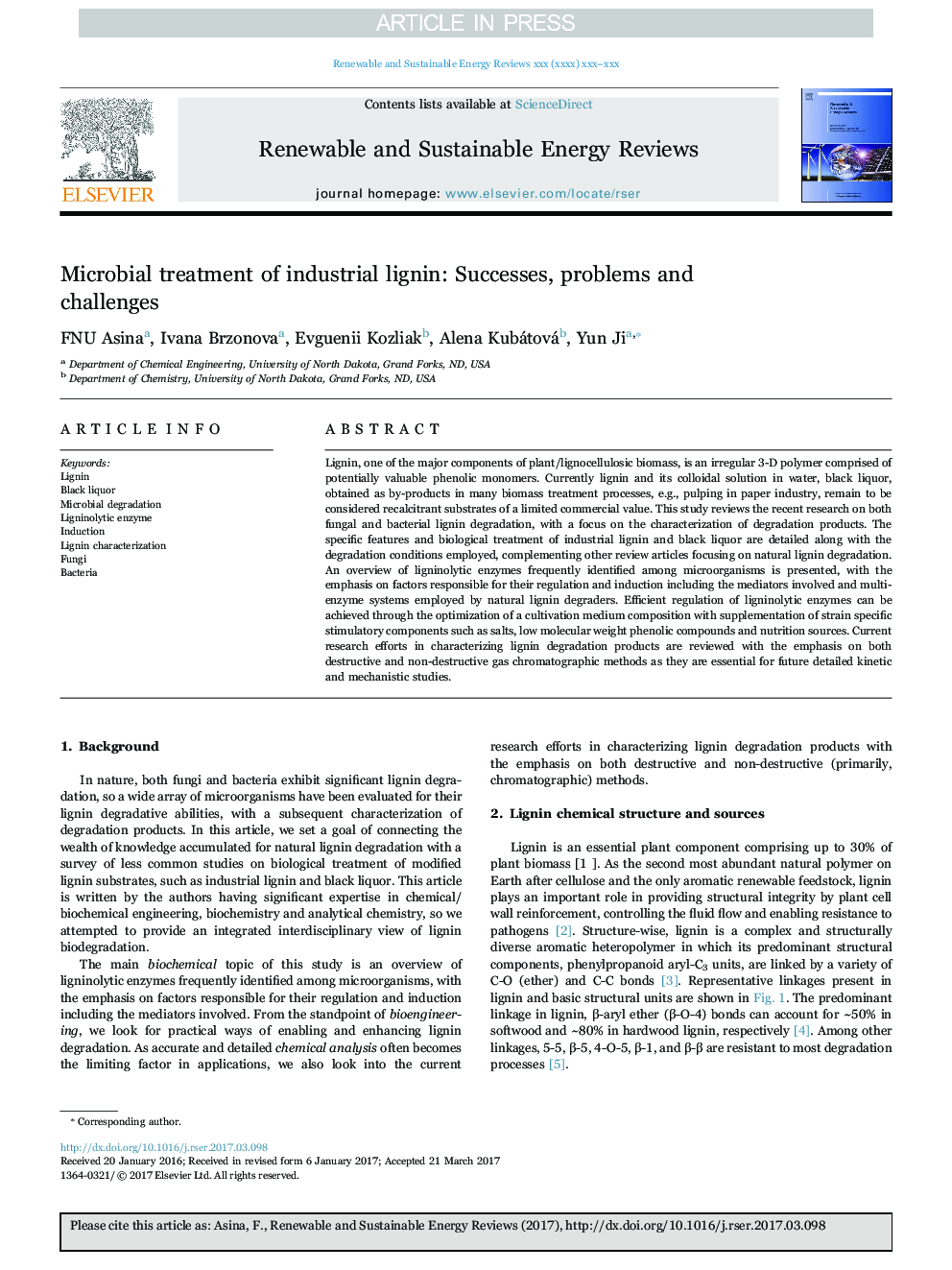| کد مقاله | کد نشریه | سال انتشار | مقاله انگلیسی | نسخه تمام متن |
|---|---|---|---|---|
| 5483002 | 1522309 | 2017 | 27 صفحه PDF | دانلود رایگان |
عنوان انگلیسی مقاله ISI
Microbial treatment of industrial lignin: Successes, problems and challenges
ترجمه فارسی عنوان
درمان میکروبی لیگنین صنعتی: موفقیت، مشکلات و چالش ها
دانلود مقاله + سفارش ترجمه
دانلود مقاله ISI انگلیسی
رایگان برای ایرانیان
کلمات کلیدی
لیگنین، مشروب سیاه، تخریب میکروبی، آنزیم لیگنینولیتیک، القایی، مشخصات لیگنین، قارچ، باکتری،
ترجمه چکیده
لیگنین، یکی از اجزای اصلی زیست توده گیاهی / لیگنوسلولوزیک، یک پلیمر سهبعدی نامنظم است که شامل مونومرهای فنولیک بالقوه ارزشمند است. در حال حاضر لیگنین و محلول کلوئیدی آن در آب، مشروط سیاه و سفید، به عنوان محصولات جانبی در بسیاری از فرایندهای فرآوری زیست توده بدست می آیند، به عنوان مثال، در صنایع کاغذ سازی خمیردندان، همچنان به عنوان زیرمجموعه های بازدارنده ای از ارزش تجاری محدود محسوب می شود. در این تحقیق، تحقیقات اخیر دربارۀ تجزیه لجن های قارچی و باکتریایی، با تمرکز بر خصوصیات محصولات تخریب، بررسی شده است. ویژگی های خاص و درمان بیولوژیکی لیگنین صنعتی و مشروب سیاه، همراه با شرایط تخریب شده مورد استفاده قرار می گیرند، علاوه بر مقالات بررسی دیگر که تمرکز بر تخریب طبیعی لیگنین را دارند، تکمیل شده است. یک مرور کلی از آنزیمهای لیگنینولیتیک که اغلب در میان میکروارگانیسم ها شناسایی می شود، با تاکید بر عوامل موثر بر تنظیم و القاء آنها، از جمله واسطه ها و سیستم های چند آنزیمی که توسط دستگاه های تجزیه کننده طبیعی لیگنین استفاده می شود، ارائه شده است. تنظیم مقادیر آنزیم های لیگنینولیتی می تواند به وسیله بهینه سازی ترکیب مرکبات کشت با افزودن مولکول های محرک خاصی مانند سدیم، ترکیبات فنولیک کم مولکولی و منابع تغذیه ای به دست آید. تلاش های پژوهشی فعلی در توصیف محصولات تخریب لیگنین با تاکید بر روش های کروماتوگرافی گاز مخرب و غیر مخرب صورت می گیرد، زیرا آنها برای مطالعات خلاقانه و مکانیکی در آینده مورد نیاز هستند.
موضوعات مرتبط
مهندسی و علوم پایه
مهندسی انرژی
انرژی های تجدید پذیر، توسعه پایدار و محیط زیست
چکیده انگلیسی
Lignin, one of the major components of plant/lignocellulosic biomass, is an irregular 3-D polymer comprised of potentially valuable phenolic monomers. Currently lignin and its colloidal solution in water, black liquor, obtained as by-products in many biomass treatment processes, e.g., pulping in paper industry, remain to be considered recalcitrant substrates of a limited commercial value. This study reviews the recent research on both fungal and bacterial lignin degradation, with a focus on the characterization of degradation products. The specific features and biological treatment of industrial lignin and black liquor are detailed along with the degradation conditions employed, complementing other review articles focusing on natural lignin degradation. An overview of ligninolytic enzymes frequently identified among microorganisms is presented, with the emphasis on factors responsible for their regulation and induction including the mediators involved and multi-enzyme systems employed by natural lignin degraders. Efficient regulation of ligninolytic enzymes can be achieved through the optimization of a cultivation medium composition with supplementation of strain specific stimulatory components such as salts, low molecular weight phenolic compounds and nutrition sources. Current research efforts in characterizing lignin degradation products are reviewed with the emphasis on both destructive and non-destructive gas chromatographic methods as they are essential for future detailed kinetic and mechanistic studies.
ناشر
Database: Elsevier - ScienceDirect (ساینس دایرکت)
Journal: Renewable and Sustainable Energy Reviews - Volume 77, September 2017, Pages 1179-1205
Journal: Renewable and Sustainable Energy Reviews - Volume 77, September 2017, Pages 1179-1205
نویسندگان
FNU Asina, Ivana Brzonova, Evguenii Kozliak, Alena Kubátová, Yun Ji,
